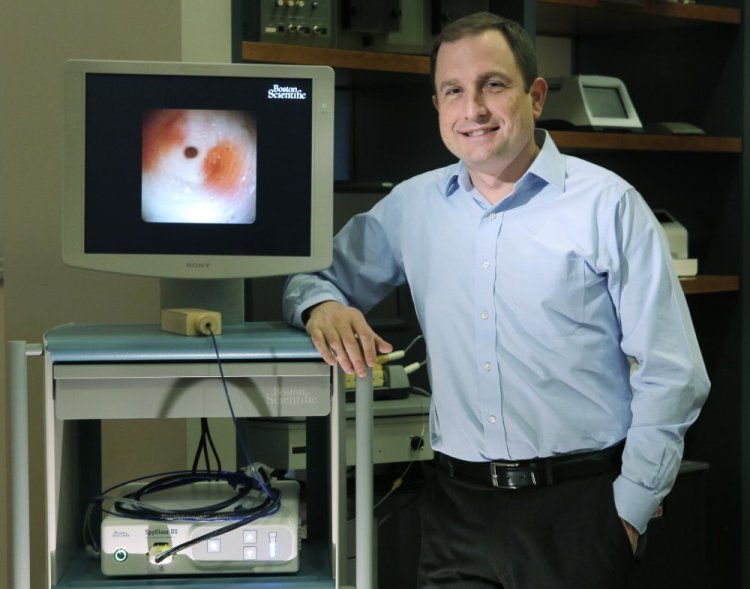When truck driver Patricia Stoddard, 50, of Madison felt sharp abdominal pain, she thought she had injured herself opening the heavier doors on her rig’s new rail container. But the pain worsened and she couldn’t keep food down, so she headed to the ER at Redington-Fairview General Hospital in Skowhegan.
“They did a CT scan and blood work and determined I had gallstones,” Stoddard said.
But there were complications, including an inflamed pancreas that had to be dealt with before her gallbladder could be removed. She was transferred by ambulance to MaineGeneral Medical Center in Augusta, one of the few locations in the state with a cutting-edge medical device made by a Maine company that could help diagnose her other issues.
The device, called the SpyGlass DS Visualization System, was designed, developed and manufactured by Gray-based Enercon Technologies for Boston Scientific, an $8-billion-a-year Massachusetts medical device maker that sells the SpyGlass DS under its brand. The endoscopic device includes a catheter, a hardware control box and a game-like controller to move the catheter in different directions inside the body.
“We were brought in to design the new generation of the SpyGlass,” said Ryan Marcotte, Enercon’s general manager.
Both Stoddard and doctors at MaineGeneral, the first hospital in the state to use the SpyGlass DS, were pleasantly surprised such sophisticated technology is made here in Maine.
“It’s amazing that it’s made in Maine,” said Dr. Fady Asslo of MaineGeneral’s gastroenterology unit in Augusta. He had used the device in New Jersey and on the West Coast but added, “I didn’t know Boston Scientific uses Maine technology. It can save some patients from having to have a surgery.”
“We can look at the stricture (blockage) in color and pinpoint the area to make the cut for the biopsy,” added Dr. Sean McGarr, director of GI oncology at MaineGeneral’s gastroenterology unit and Stoddard’s doctor. Previously, surgery was needed to get such an accurate biopsy.
MEDICAL AND OTHER DEVIcES
A walk through Enercon’s 35,000-square-foot headquarters and factory reveals many readily recognizable brands, most of which are manufactured under nondisclosure agreements. One product Enercon can talk about is the Veinsite headset from fellow Gray-based company VueTek Scientific LLC. That device lets physicians view hard-to-see blood vessels when drawing blood or inserting intravenous needles into children, the elderly and those with darker skin.
Two-thirds of Enercon’s business is from medical devices it produces for others, but it also makes other devices, such as specialized LED lighting for stage work, department stores and museum displays.
Founded in 1980, Enercon has 140 employees and would only say its revenue has grown in double digits annually since 2009. It’s currently expanding in multiple stages with a new 69,000-plus square-foot building, and eventually will almost quadruple in size.
McGarr figured MaineGeneral has performed about 60 of the procedures using SpyGlass DS since it began on Oct. 2. A nurse at the hospital said she is pleased a product produced by a Maine company is being used by a Maine community hospital to provide high-quality care close to a patient’s home.
For Stoddard, whose condition flared up in late October, it was a choice of being transferred 40 miles to Augusta or 100 miles to a hospital in Portland.
“Not everyone does the biliary work,” McGarr said of the SpyGlass DS. “So we’ve become a biliary center. People get sent here for that reason.”
GOING DIGITAL
Improvements to the original SpyGlass include making it easier to use and maneuver inside the patient’s body, making it digital and adding color.
“The new digital model shows doctors a larger area of tissue more clearly,” Marcotte said. “In the past, that could only be accomplished through surgery.” That also means they can better see and snip a sample of the precise tissue they think is problematic.
That was the case with Stoddard. Her combination of ailments in hard-to-reach body areas made it difficult to see exactly what was wrong. After a series of tests, doctors found her common bile duct also was blocked, possibly by a cancerous mass, and her pancreas, in turn, was inflamed.
Because of her pancreatitis, she could not hold down liquids or food. In the body, the bile duct carries bile, which aids in digestion and rids the body of waste, from the gallbladder and liver through the pancreas to the small intestine.
The first order of business was to treat the pancreas. Stoddard said McGarr used a procedure called endoscopic retrograde cholangiopancreatography, or ERCP, to thread the SpyGlass DS catheter into her common bile duct to see if there also were bile duct stones there or a mass that might be cancerous.
Stoddard said the doctor used the SpyGlass DS and discovered sludgelike material blocking her bile duct and installed a stent to open up the small vessels in the duct to allow the pancreas to heal.
“I wouldn’t wish this on my worst enemy,” Stoddard said. She lost about 30 pounds over six weeks and spent time in the hospital on three separate occasions.
This story was updated at 10:30 a.m. Jan. 30 to update Patricia Stoddard’s diagnosis. Since the initial interview, Stoddard’s condition has worsened and she is now in stage four pancreatic cancer.
Send questions/comments to the editors.



Success. Please wait for the page to reload. If the page does not reload within 5 seconds, please refresh the page.
Enter your email and password to access comments.
Hi, to comment on stories you must . This profile is in addition to your subscription and website login.
Already have a commenting profile? .
Invalid username/password.
Please check your email to confirm and complete your registration.
Only subscribers are eligible to post comments. Please subscribe or login first for digital access. Here’s why.
Use the form below to reset your password. When you've submitted your account email, we will send an email with a reset code.